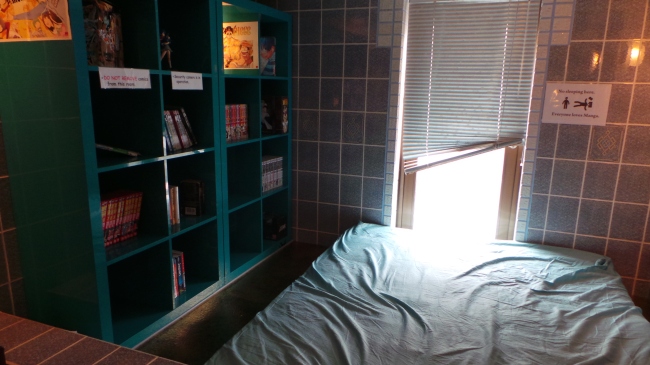I wake up to the birds cheeping outside and the sun blazing through the window. An early start today in the far too hotter than I’m used to 30°C Tokyo sunshine finds me out and about for 9 a.m. I head across to the bar I had been the previous evening, which luckily for me, doubles up as a vegan and vegetarian restaurant in the day time; and only a 45 second walk from my hostel too. After a breakfast of beans, egg, and toast, washed down with a damn fine cup of coffee, it’s time for a stroll.
I take a five-minute walk to Senso-ji, a Buddhist Temple in Asakusa and the oldest temple in Tokyo. The entrance to the temple is marked by a giant red and white lantern, and probably the largest lantern I have seen in my life. This section is known as Kaminarimon, or the Thunder Gate. Standing either side of the gate are two large statues, the one on the left, I am told, is Fujin, the god of wind; and to the right, Raijin, the god of thunder.
Continuing towards the temple, there’s a line of over 80 stalls offering fans, umbrellas, souvenirs, and an array of food items (bean paste buns and rice crackers seem to be popular today), along with clothing, handbags, and even a stall claiming to sell tortoise shell and coral. Known as Nakamise-Dori, this stretch forms a beautiful lantern-lit pathway of stalls leading to the temple.
In the temple courtyard stands Goju-no-To, a five-story pagoda that stands at 53 metres tall, making it the second-highest pagoda in all of Japan. Prior to the temple entrance, there’s a massive cauldron emitting thick incense smoke. This cauldron marks the threshold before the entrance to the Hondo, or Main Hall. Inside the Main Hall, a striking golden statue of Kannon, the goddess of mercy, awaits. Legend claims the statue was retrieved from a lake in the year 628 AD by two fishermen.
After some sightseeing around the temple, I head to a nearby shaded indoor market. After a short while, I notice a woman who, for no apparent reason, is strolling through the market balancing a bottle of green tea on her head. As she passes by, I stop and turn around to confirm what I had just witnessed – indeed, a woman balancing a bottle of green tea on her head. In the process, I almost get knocked over by a passing cyclist.
Upon returning to the hostel, I start feeling somewhat tired: a touch of jet lag, extended periods of wakefulness, and my newfound, albeit very healthy diet of Suntory Black Boss Coffee being the obvious causes. I opt to take a nap.
I awaken. It’s 8 p.m., and outside, the darkness of the sky has been replaced by the brilliance of vibrant neon lights. I realise that Japan takes on a strikingly different appearance in the evening. I begin my walk back toward Senso-ji, passing by pachinko parlours, game arcades, and brightly lit restaurants that seemed non-existent earlier today. The streets are now bustling with people seated at tables, dining. Shutters down, shutters up—there isn’t a clothing shop in sight; everything has been transformed into restaurants.
I return to Senso-ji to witness the Pagoda and Temple illuminated at night—an impressive sight. Strolling back through Nakamise-Dori, almost all of the 80 stalls are now closed with their shutters down. Only a single food stall remains open; it’s time to find something to eat.
I opt for a tempura restaurant that proudly boasts an English menu. According to the menu, their prawns are exceptionally tasty due to being raised using extensive aquaculture—an environmentally friendly method. They exclusively use 100 percent vegetable oil with no cholesterol. Ordering a tempura set with noodles and a pint of Kirin Beer, I indulge in tempura sweet potato, lotus root, squid, and prawn, all served on a bed of rice. While the squid tempura is remarkable, the standout, confirming the menu’s claim, happens to be the most delectable prawn I’ve ever tasted.
The meal, including the beer, costs me ¥1060—an incredibly reasonable price indeed.
Deciding to conclude the night back at the hostel, my appetite is thoroughly satisfied. I purchase a few affordable cans of Asahi from the vending machines and head to my room, where I’m greeted by a few fellow roommates. A lady from Taiwan offers me some squid on a stick. ‘Try it,’ she says with a grin, ‘it’s nice and a little bit spicy too!’ For some reason, I agree to give it a try.
Two minutes later, I’m still at the tap, trying to wash away the taste of what must have been the most disgusting food I have ever tasted. The texture was chewy, the taste was off, the regret was apparent.
My second day in Japan oddly mirrored by both morning and evening visits to Senso-ji Temple: walking the same streets once bathed in the brightness of a hot sunny day and then again in the neon-lit darkness of the night; and some food to remember, followed by food to forget.

![restaurants[1]](https://japanising.com/wp-content/uploads/2014/05/restaurants1.jpg?w=630&h=354)
![tenpura[1]](https://japanising.com/wp-content/uploads/2014/05/tenpura1.jpg?w=630&h=354)

![20140529_201217[1]](https://japanising.com/wp-content/uploads/2014/05/20140529_2012171.jpg?w=630&h=354)
![20140529_205706[1]](https://japanising.com/wp-content/uploads/2014/05/20140529_2057061.jpg?w=630&h=354)
You must be logged in to post a comment.